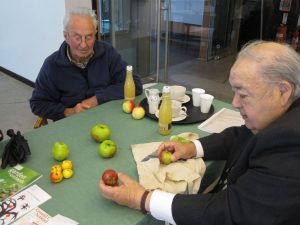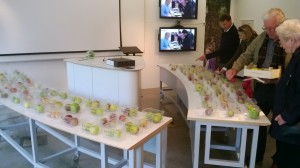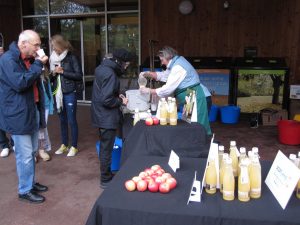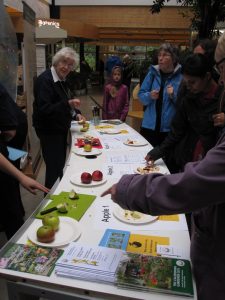Apples are a feast for the senses. The variety of size and colour is incredible. Small varieties have fruits little bigger than a golf ball while the aptly named ‘Catshead’ is much larger than the average moggies head. Colour varies from lemon yellows through greens and browns to reds and even deep burgundy. Many varieties are bicoloured and striped. The smell of a large display of apples is intense and floral. And all this without even thinking about flavour. To adequately describe the diverse flavours of apples would tax the vocabulary of the most experienced taster.

Willie Duncan was kept busy identifying apples for the public throughout the weekend and his outstanding contribution to apple culture in Scotland was recognised with an award at the end of the festival
Although there are more than 7,500 named cultivars of apple less than half a dozen will typically be on sale in a British supermarket. Production in the northern and southern hemisphere and controlled storage means that the same half dozen apple varieties are on the supermarket shelves pretty much year round. The bland uniformity that we have all become accustomed to is shown up for what it is by the displays seen at ‘Apple Days’ all over Britain during October. On the 5th and 6th October The Botanics held its own annual Apple Festival and over 90 varieties were on display. There was a good representation of Scottish heritage varieties with wonderful names like ‘Bloody Ploughman’ and ‘Lass o Gowrie’ thanks to the extensive collection of apples supplied by Willie Duncan from Fife.
Tasting apples was a big part of the festival. The restaurant in the John Hope Gateway put apples on all three courses of the ‘Specials’ board over the weekend. The old Scottish variety ‘Hawthornden’ was used with supplies coming from the garden of East Linton apple enthusiast David Affleck. Apple juice tasting was provided by Innerleithen-based artisan juice producer Graham Stoddart of Cuddybridge Apple Juice.
Many visitors to the Apple Festival got involved in taste tests. These were mainly about enjoying apples and apple products but some interesting trends emerged from them. The John Hope Gateway restaurant baked pastries with two old Scottish cooking apples ‘White Melrose’ and ‘Hawthornden’ and the tasters were pretty evenly split when asked which they preferred. The Royal Caledonian Horticultural Society provided fresh apple tasting of a range of varieties, old and new, supplied by RHS Wisley. The same recipe for apple jelly was used with two different apples and a blind taste test showed a clear preference for the more tart flavour of the wild crab apple Malus pumila over the renowned jelly making variety ‘Keswick Codlin’ with 65% prefering the crab.



